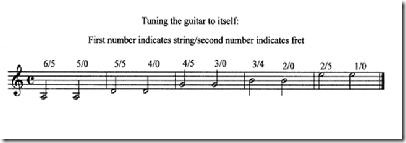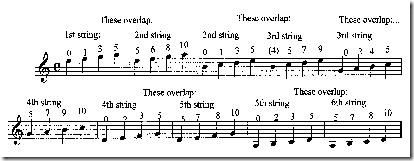How many of you started playing using the Mel Bay Modern Guitar Method in seven volumes? How many volumes did you complete before moving on to a different teacher -- one who used a different method? Yup, I'll admit it, I only got half way through volume five before I moved on to classical guitar. I have had to go through the remainder of the method much later on because I use this method for most of my students who are not sure if they are going to move on to classical. I love the Mel Bay method. Old Mel was really thorough in his pedagogical dissertations. Love the guy.
Recently a friend of mine had completed volume one and was a few pages into volume two. She is a great sight-reader -- until you get above the fifth fret. Then her calm and professional attitude takes a hike. The palms sweat, the head hangs low and she claims she can't read! It is as if all the careful instruction she has received and hard work and practice she has invested has not prepared her for the fact that the instrument does not intrinsically change once past that imaginery boundary. "There's a dot there, something must be different!" The guitar is laid out in half steps from stem to stern. If you can count, you can read. If you can recognize the pattern that the intervals definitely form, you can read anywhere on the neck! Radical statement? Nope. I am going to free up your thinking when it comes to the fingerboard and unlock 'all those strange notes' that fall in that great unwashed section of neck between the fifth and twelfth fret.
Let's start at the fifth fret. Any guitar student who has gotten through the first five pages (I think, don't quote me) of Mel Bay Volume One can tune the guitar (or at least have been shown how to tune the guitar) to itself using the overlap tones at the fifth fret. (See the example above.) We all know the drill. Depress the sixth string at the fifth fret. The pitch produced is the same pitch as the open fifth string. Okay. You know full well that the open fifth string's pitch is the A below middle C. (Two ledger lines below the treble clef staff.) So far so good. The fifth fret of the fifth string produces the same pitch as the open fourth string. Ditto until you get past the third string. The second string open is tuned to the fourth fret of the third string. Things go back to normal when you tune the first string from the second. Yeah, the fifth fret of the second string produces the E note that is the top space of the treble clef staff which is also our open first string. Knowing this yields the following chart:
See? You DO know the notes on the fifth fret! Well, once the student has a good feel for these 'new' notes at the fifth fret, we can draw a few decent conclusions simply using the wisdom gleaned from the open position reading exercises Mr. Bay taught us way back when. Look at the following chart of notes. The odd number measures show the open string stuff we learned in volume one. The even measures show these same notes on the corresponding strings from the fifth fret up. In other words. that E, F, and G played on the open first and third frets of the first string are played on the fifth, sixth and eighth fret on the second string. The same half and whole steps are present with E, F and G no matter where you play 'em. Believe it or not, this comes as a revelation to some students.
This is all well and good as a mental exercise, but how do you make it 'real' to the student? Well, how about going to old Mel himself? You've seen this chestnut before -- it's Mel Bay's Etude for the first string:
Copyright 1948 and renewed by Mel Bay Publications Inc. Pacific, MO USA.
All the students played this one on the first string. Try it now with the first finger playing that E on the second string fifth fret, F on the sixth fret and G on the eighth fret. Works just fine. I use this trick on my older students (it freaks the kids out, but a 13 year-old can handle it.) The I hit them with:
Copyright 1948 and renewed by Mel Bay Publications Inc. Pacific, MO USA.
And I tell 'em to play it on the third string! It puts the student up on the ninth through twelfth frets on the third string which also reenforces the concept of the octave from the open G string to the twelfth fret. Look through volume one and you'll see similar 'tricks' you can pull on your students to get them to think away from the open position. The sooner they get used to reading all over the neck, the easier their further studies will become. That's it for today. But it isn't the end. I've got a million little neat tricks to train up that next generation of serious player.















No comments:
Post a Comment